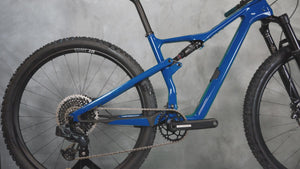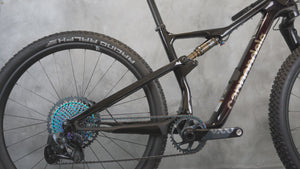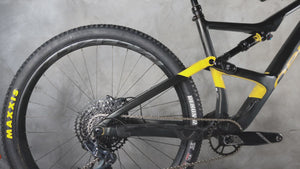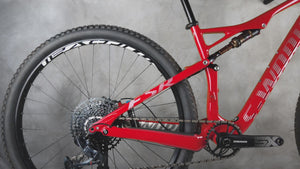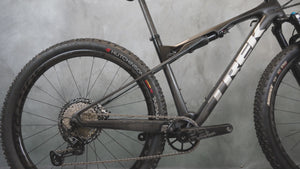Integral suspension, Trail, Enduro, Cross-Country ...: Which mountain biking to choose?
Posted on February 7, 2022
In front of the multitude of models, technologies and possible uses, the choice of a mountain bike can quickly become very complex even for confirmed cyclists. Material, Wheel diameter, suspension type, convenient, etc. This article gives you the keys to help you find the bike that will suit you best.
If you are new in the mountain biking world, we advise you to start with our Buying guide: Used ATV. You will then be able to deepen your criteria of choice and understand the other elements to take into account when buying a ATV by reading this article.
Here are the considerations we explore:
- Cyclist type
- Types of ATV
- Wheel size
- Transmission technology
- Telescopic saddle stem
Cyclist type
Here is a practical exercise that will help you define your type of driving and reducing your bicycle choices: Imagine the scenario of your dreams.
- What type of cyclist are you?
- How will you use your bike?
 Is that how you see you down the slopes? Or in a little different way?
Is that how you see you down the slopes? Or in a little different way?
Do you see you hit the tracks at high speed, take turns thoroughly and skip jumps? Do you imagine hills on a "featherweight" bike, to travel long distances or climb summits? Are you interested more about the descent or climb experience?
Understand how you imagine your adventures will finally be the compass that will guide you to the good mountain bike. The more descent you are, the more your bike must be of the "enduro" type. The more weight, the mounting ease and the effectiveness of the pedaling are important for you, the more your bike must be Cross-Country or "XC".
Types of ATV

Full suspension
The integral suspension bikes use a shock absorber and a linkage to provide additional suspension at the back. As noted previously, the main advantage of a power-up bike is that the rear suspension helps absorb shocks, gives cyclists a larger margin of error when they come down a high-speed trail and improves comfort on the comfort. rugged terrain. There is a wide range of travel options, depending on the driving style you prefer.
 The suspension is a major concern for Used ATV. The fork and shock absorber are put to the test and should generally be well maintained to keep all their performance. When you search for used ATVs, it is good to provide a little budget in case a fork or shock absorber overhaul after purchase is needed. Fortunately, all components of the suspension of certified used bikes are inspected and maintained by our mechanics, so that they are always ready to operate as soon as they leave the box.
The suspension is a major concern for Used ATV. The fork and shock absorber are put to the test and should generally be well maintained to keep all their performance. When you search for used ATVs, it is good to provide a little budget in case a fork or shock absorber overhaul after purchase is needed. Fortunately, all components of the suspension of certified used bikes are inspected and maintained by our mechanics, so that they are always ready to operate as soon as they leave the box.
Choose an integral suspension bike if you like to ride on more accident trails or need a bike that supports you more in the descents. Full-suspension bikes weigh a little more than equivalent hardtails, but many modern models are still relatively effective and offer you extra comfort on the more technical lands.
XC (Cross-Country): 100-120 mm rear travel
The XC (or cross country) mountain bikes are designed to be faster and more efficient to climb, sprinter and quickly cover the ground. XC bikes are often lighter and have a quick and responsive handling. They are suitable for cyclists who look for form, speed and climb, endurance and long distances, as well as XC races.

Trail: 120-150mm rear travel
Trail mountain bikes are versatile bicycles, halfway between XC and enduro. In general, these bicycles are in the middle in terms of power, clearance, weight and geometry. They are suitable for a wide range of climbs and descents, and are generally the best choice for the majority of cyclists who seek to have fun and travel a wide variety of trails.
Enduro: 150mm + rear travel
Enduro mountain bikes are designed for descent. Most enduro bikes have a larger suspension movement, aggressive geometry focused on descent stability rather than rapid climbing, and heavier and more robust components. They are perfect for steep and technical land, bicycle parks and enduro races.

Hardtail
The hardtails have a fork suspended at the front of the bike and a rigid rear. As a hardtail does not have a rear shock absorber or movable linkage required for the rear suspension, it is often cheaper and easier to maintain. Hardtails are very effective when pedal, because there is no rear suspension that can deform or sag. Hardtails are a popular option for XC riders looking for the lightest and most efficient bike. Hardtails XC and Trail are the most common, but there are enduro hardtails for those looking for a unique driving experience.
On the accident and technical trails, they ask for more precautions as to the technique and the choice of the trail, because the back forgives less errors and big shocks. Choose a Hardtail if you are looking for a simpler and more reliable bike, or easier and cheaper to maintain, or if you want an ultra-light XC racing bike. A hardtail can also be equipped with a rigid front fork instead of a suspended fork. A fully rigid mountain bike can be difficult to drive, but as there is no suspension to sag or move, rigid bikes are incredibly efficient and light.
Wheel size
At first, the 26-inch wheels were the norm for ATVs. But over the years, new wheeled sizes took over. The second-hand mountain bike market is now filled with a plethora of size options, each with different features, advantages and disadvantages. Cyclists can choose and experiment with wheels and tires that suit them best.
The classic 26-inch wheels are mostly defeated, but that means you can often find 26-inch bikes in a good price, provided you agree with compatibility issues and availability Reduced new pieces. Otherwise, it is best to search for a used ATV using one of the options below.
*Note: The majority of ATVs have Tubeless-Ready tires. Non tubeless options are becoming increasingly rare, even on the second-hand market. Any modern mountain bike should be tubeless nowadays.
27,5"
27.5 "is the smallest running wheel size on modern bikes and has replaced the traditional wheels of 26" as the smallest wheel size for enduro bikes and descent. It is ideal for those who want a playful bike, which are jumping and steep and technical pistes, or for small cyclists who find the wheels of 29 inches too bulky.
27,5+
27.5+ refers to wheels designed for 27.5 inches tires, with a width of between 2.8 and 3 inches. They are often called "more" bikes. This wider tire offers more adhesion and a more flexible driving thanks to a larger volume of air. Some models of bicycles can go from a wheel of 27.5+ to a 29 "wheel because they have a similar diameter. This is a good size of tire for those looking for greater confidence and better adhesion under unstable conditions, or more comfort during long hikes.
29"
The wheels of 29 "have a larger diameter, which allows mountain biking to keep its speed and momentum on rugged ground. This is the most popular option on modern cross-country bicycles. They start to become popular in enduro and downhill. It's a good wheel size for cross-country runners, trail runners or enduro more interested in straight-line speed than handling, or cyclists of big size.
29+
29+ refers to the wheels designed to accommodate 29-inch tires with a width of between 2.8 and 3.0 inches. This wider tire offers more adhesion and softer driving thanks to a larger volume of air. The 29+ is the largest mountain bike tire diameter and has the highest weight. The 29+ is popular for applications such as bikepacking and is suitable for cyclists who are looking for more comfort and traction. Small cyclists, on the other hand, can find them too big.
Fat
Fat bikes are specialized bikes. To be considered a Fat Bike, the wheels are 26 inches (sometimes 27.5 inches) and the tires generally have a width of between 3.8 and 5 inches. This ultra wide rubber allows Fat Bikes to roll with a certain "floating", that is to say that the tire does not sin into the surface of the trail. This makes Fat Bikes the ideal choice for rolling in unique conditions like snow and deep sand. The wider the tire, the more floating it is.
Transmission technology
 Transmissions with a single front tray are known as 1x (pronounced "one by"). 1x transmissions are the most common option for modern ATV due to their increased simplicity and reliability.
Transmissions with a single front tray are known as 1x (pronounced "one by"). 1x transmissions are the most common option for modern ATV due to their increased simplicity and reliability.
1x transmissions use a tray with a "narrow and wide" tooth profile that prevents the chain from falling from the tray on an rugged ground, as well as a clutch rear derailleur that helps the chain retention by maintaining a constant tension. .
Shimano is currently the only manufacturer who still offers a transmission 2x ("two by"), but it becomes more and more rare.
Single speed transmissions are another option, which is most often found on the hardtails. They are simple, inexpensive and require very little maintenance. But know that you will need a good physical condition if you want to browse trails with sustained or steep mounted.
With each generation, transmissions manufacturers have been able to add sprockets on the cassette to increase the number of speeds. The latest shimano and SRAM transmissions have 12 speeds. The advantage of a larger number of speeds is that it makes it possible to expand the speed range. Old 10 or 11-speed transmissions work very well and are cheaper, but they do not offer a wide range of speeds.
If you want the last and the best technology, Shimano and SRAM also offer electronic transmissions. Shimano DI2 and SRAM Eagle AXS transmissions use batteries and engines to change speed and represent the future of transmission technology.
To know more : Electric transmission vs. Mechanical: Advantages and disadvantages
Telescopic saddle stem
One of the greatest recent innovations enjoyed by mountain bikers is the telescopic saddle stem. This is hydraulic or spring, adjustable in height. These rods are generally controlled by a remote control at the handlebar, which allows the cyclist to instantly lower his saddle.
For optimal pedaling, you need a good leg extension to generate power and be effective. However, a saddle positioned for optimal pedaling is usually too high so that most cyclists can come down comfortably. A lowered saddle allows you to easily maneuver the bike under you during turns or descents on steep and technical land.
As the suspensions, the saddle rods of the mountain bikes are staggering. They often have a bad reputation for reliability. In case of collapse, friction, leaks or other problems, it is necessary to revise or replace the rod. It is often expected and it's not a problem when buying a used ATV, as long as you have planned the necessary budget. As for the suspensions, The Cyclist House inspects and maintains the saddle stems on all our second-hand certified ATVs, which avoids you to worry.
Some cyclists may find that they do not need a telescopic saddle rod. Either their local trails are not technical enough to justify its use, either they are concerned about the weight that a telescopic saddle stem adds with respect to a conventional saddle stem. This is the reason why many cross-country riders use this type of stem and XC bikes are not equipped.
In the end, it is at each cyclist to decide if a telescopic saddle stem is necessary or not, but it is a feature that is worth taking into account when buying a new bike . They are ideal for new cyclists because they allow them to descend with more confidence and security. Such a rod can be added or removed as needed.
We hope that this guide has allowed you to learn one or two things on mountain biking and having a good idea of the type of bike you want for your adventures. Remember that if you need help, you can always contact our expertise to help you !
























